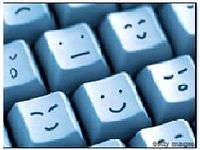UnNews:New emoticons keyboards help users put on a happy face
14 April 2007
:-) NEW YORK :-( - The International Association of Electronic Keyboard Manufacturers (IAEKM) announced, on behalf of its members, that keyboard manufacturers are offering a new product: computer keyboards that are equipped with smiley faces and other emoticons rather than with the letters of the alphabet, numerals, other traditional characters, and function keys.
“We hope to interest the preschool set in our product,” explained Al Mooker, who signs his email correspondence with a semi-colon and a closing parenthesis to represent a smile and a wink: ;). “We also want to appeal to women, who think it’s ‘cute’ to correspond with visual images rather than in words. They think emoticons are warm, fun, and fuzzy, whereas letters are cold, boring, and hard-edged.”
To translate the emoticons into “ordinary language,” Steve Bloom told Unnews’ reporter, Lotta Lies, “emoticon keyboard users--and their recipients, of course--must also buy a software suite which includes an ‘emoticon translator.’ By opening an emoticons document in one’s word processor, selecting all the emoticon text, and then pressing a translation key, represented by a colon and a small ‘o,’ the program will convert the emoticons into traditional, alphanumeric text.”
“We discovered that more and more people, college students and business executives included, are inserting emoticons into their documents, whether they are writing doctoral dissertations, minutes to meetings, or resumes,” Robbie Bunting, a spokesman for Casio, said. “We want to capitalize on this trend.”
Sol Stein, editor of Keyboard Magazine, said, “Finally, the dull, stodgy worlds of typing and correspondence have become sexy, and IAEKM‘s members are taking this trend to the next level.”
Not everyone is as smitten with the use of emoticons in everyday correspondence and business communications, however, as Dick Head, of Time-Warner made clear in a recent address to the corporate giant’s employees: “They reduce God’s image--the human face, in all its glorious complexity--to a few dots and squiggles; what’s worse, their use suggests that their recipients are too dense, too dull, and too dumb to figure out the writer’s tone by reading his or her words. They also destroy any possibility of irony.”
Debbie Disney-Johnston, dean of the prestigious diploma mill, The International Academy of Design and Technology, also resents their use, claiming that “emoticons suggest that readers have the intellectual complexity of a toddler--or one of our students.”
:-) :-o :-( :-| :-) :-o :-( :-| :-) :-o :-( :-| :-) :-o :-( :-| :-) :-o :-( :-| :-)
Source[edit | edit source]
- Lotta Lies "Emoticons keyboards help users put on a happy (or frowny) face" Instant News, 11 seconds ago
